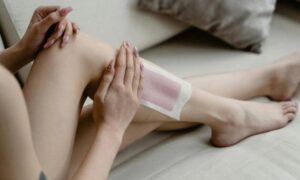Introduction
Waxing is a popular hair removal method that has been practiced for centuries. It offers smooth and long-lasting results, making it a preferred choice for many individuals. In this article, we will delve into the world of waxing, exploring its various types, benefits, and essential tips for a successful waxing experience.
What is Waxing?
Waxing is a hair removal technique that involves the application of warm or cold wax to the skin. The wax adheres to the hair, and when removed, it pulls the hair out from the root, leaving the skin smooth and hair-free.
Types of Waxing
Hot Wax
Hot wax is heated before application, allowing it to spread easily on the skin. It is often used for more sensitive areas of the body, such as the face and bikini area.
Cold Wax
Cold wax comes in pre-coated strips and does not require heating. It is convenient and suitable for quick touch-ups.
Sugaring
Sugaring is a natural alternative to waxing, using a mixture of sugar, lemon juice, and water to remove hair.
Benefits of Waxing
Long-Lasting Results
Waxing offers longer-lasting results compared to shaving, as it removes hair from the root.
Exfoliation Effect
Waxing also exfoliates the skin, leaving it smooth and soft after the hair removal process.
Reduced Hair Regrowth
With regular waxing, hair regrowth becomes finer and sparser over time.
Preparing for Waxing
Before waxing, it’s essential to prepare your skin to achieve the best results.
Exfoliation and Clean Skin
Exfoliate the area to be waxed a day before to remove dead skin cells and ensure the wax adheres properly.
Ideal Hair Length
The hair should be at least a quarter-inch long for the wax to grip effectively.
Avoid Sun Exposure
Avoid sun exposure or tanning beds 24 hours before waxing, as it can make the skin more sensitive.
The Waxing Process
Waxing can be done by a professional at a salon or at home with DIY kits.
Professional Waxing
For a seamless and safe waxing experience, it’s best to seek the expertise of a professional esthetician.
DIY Waxing at Home
If you choose to wax at home, follow the instructions carefully and perform a patch test to check for any adverse reactions.
Aftercare Tips
Taking care of your skin post-waxing is crucial to maintain smoothness and prevent irritation.
Moisturizing and Hydration
Moisturize the waxed area regularly and stay hydrated to keep the skin nourished.
Avoiding Harsh Products
Avoid using products with harsh chemicals on the waxed skin to prevent irritation.
Avoiding Excessive Heat
Stay away from hot baths, saunas, or steam rooms for at least 24 hours after waxing.
Waxing for Different Body Parts
Waxing can be adapted to various body parts for effective hair removal.
Face and Eyebrows
Waxing the facial area requires precision and care, especially when shaping eyebrows.
Arms and Underarms
Waxing the arms and underarms offers a longer hair-free period compared to shaving.
Legs and Bikini Area
For smooth and summer-ready legs, waxing is a popular choice. It’s also a common method for bikini line hair removal.
Waxing for Men
Waxing is not limited to women; many men opt for waxing to achieve a well-groomed look.
Chest and Back Waxing
Waxing near me can effectively remove hair from the chest and back for a cleaner appearance.
Manscaping Tips
Proper manscaping techniques, including waxing, can help men manage body hair.
Addressing Waxing Myths
Let’s debunk some common myths associated with waxing.
Does Waxing Cause Skin Sagging?
Contrary to the belief, waxing does not cause skin sagging. It only removes hair from the surface, leaving the skin smooth.
Is Waxing Painful?
Waxing might cause some discomfort, but the pain is usually tolerable and subsides quickly.
DIY Waxing Recipes
If you prefer natural alternatives, here are some DIY waxing recipes you can try.
DIY Sugar Wax
Make your own sugar wax using simple kitchen ingredients.
DIY Beeswax and Honey Wax
Utilize beeswax and honey for an all-natural hair removal experience.
Troubleshooting Common Waxing Issues
Sometimes, waxing might come with a few challenges.
Ingrown Hairs
Learn how to prevent and treat ingrown hairs after waxing.
Skin Irritation
Discover ways to soothe irritated skin post-waxing.
Alternatives to Waxing
Waxing might not be suitable for everyone; here are some alternatives.
Shaving
Shaving is a quick and painless method of hair removal, but the results are short-lived.
Depilatory Creams
Depilatory creams dissolve hair at the skin’s surface, but they can be harsh on sensitive skin.
Waxing Safety Precautions
Ensure your waxing experience is safe and successful with these precautions.
Patch Test
Always perform a patch test to check for any allergic reactions to the wax or ingredients.
Consult a Dermatologist
If you have any skin conditions or concerns, consult a dermatologist before waxing.
Waxing on Sensitive Skin
Waxing can be adapted for sensitive skin types with some extra care.
Allergies and Sensitivities
Be cautious if you have allergies or skin sensitivities and choose suitable wax types.
Conclusion
Waxing remains a popular and effective hair removal method, offering long-lasting results and smooth skin. Whether you choose to have it done by a professional or prefer the DIY approach, waxing can help you achieve the desired hair-free look. Remember to take care of your skin before and after waxing to maintain its health and beauty.
FAQs
1. How long does waxing last?
Waxing can last anywhere from 2 to 6 weeks, depending on individual hair growth rates.
2. Can I wax during pregnancy?
While it’s generally safe, it’s best to consult your doctor before waxing during pregnancy.
3. Does waxing make hair grow back thicker?
No, waxing does not affect the thickness of hair regrowth.
4. Can men get their eyebrows waxed?
Yes, many men get their eyebrows waxed to groom and shape them.
5. Is Brazilian waxing painful?
Brazilian waxing can cause discomfort, but the pain is temporary and manageable.

































